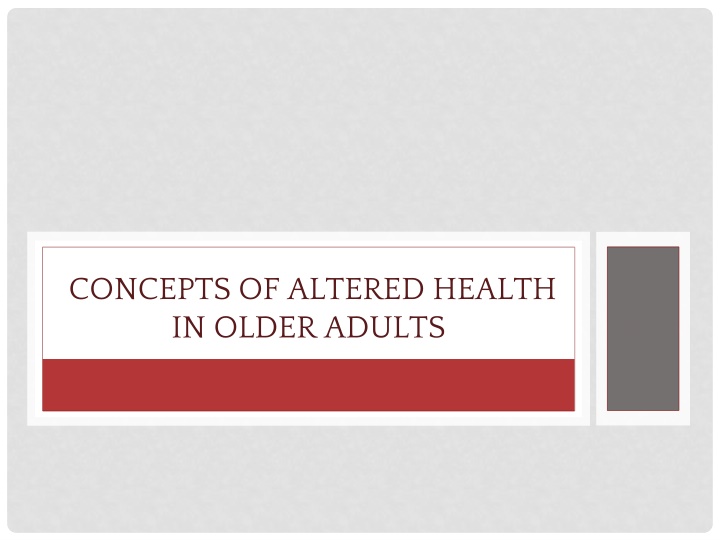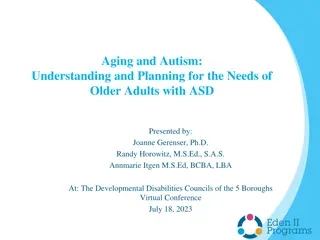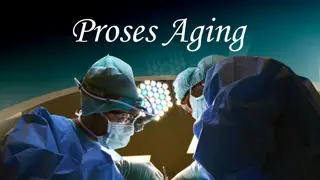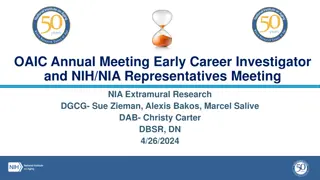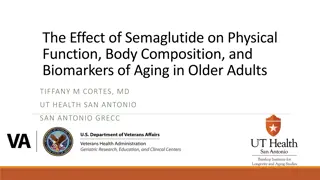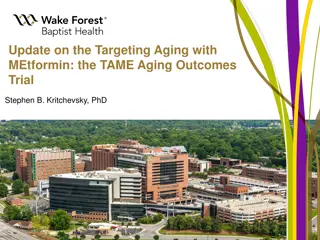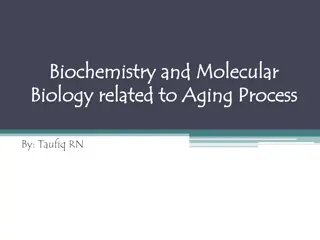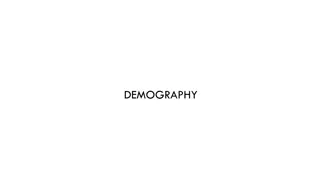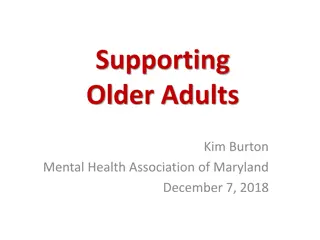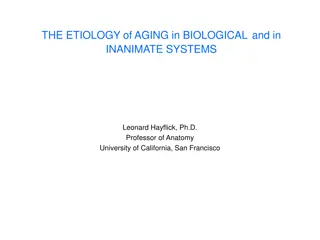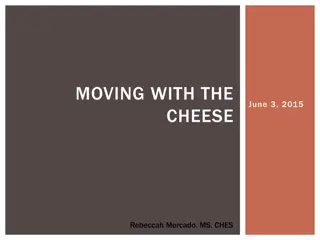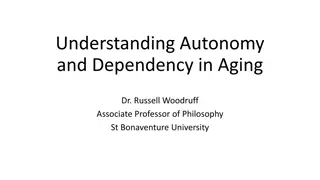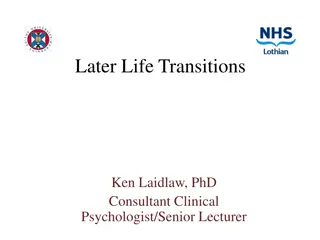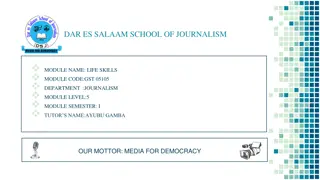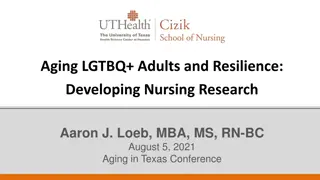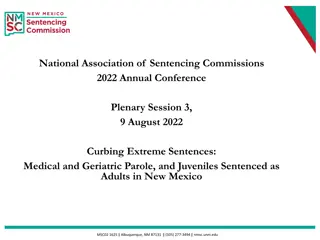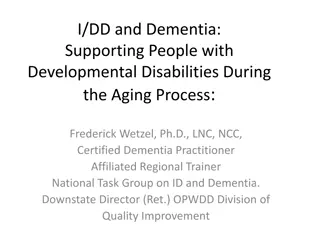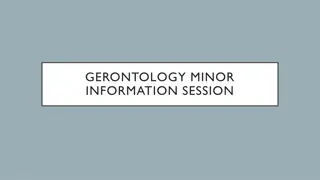Insights into Aging: Health, Population, and Challenges
Exploring the concepts of altered health in older adults, subgroups within the elderly population, gerontology as a discipline, statistics related to the elderly population, common health issues among the elderly, assets and income sources, as well as the issues and positive aspects faced by the elderly.
Download Presentation

Please find below an Image/Link to download the presentation.
The content on the website is provided AS IS for your information and personal use only. It may not be sold, licensed, or shared on other websites without obtaining consent from the author.If you encounter any issues during the download, it is possible that the publisher has removed the file from their server.
You are allowed to download the files provided on this website for personal or commercial use, subject to the condition that they are used lawfully. All files are the property of their respective owners.
The content on the website is provided AS IS for your information and personal use only. It may not be sold, licensed, or shared on other websites without obtaining consent from the author.
E N D
Presentation Transcript
CONCEPTS OF ALTERED HEALTH IN OLDER ADULTS
SUBGROUPS OF THE ELDERLY Young-old: 65 to 74 years Middle-old: 75 to 84 years Old-old: 85+ years
GERONTOLOGY Definition A discipline that studies aging and the aged from biologic, psychological, and sociologic perspectives Goals To explore the dynamic processes of complex physical changes, adjustments in psychological functioning, and alterations in social identities To assist older adults to maximize functional ability and prevent and minimize illness and disability
THE ELDERLY POPULATION (STATISTICS) Most live in community settings Most live in family settings with spouse, children, or other relatives Approximately 24% live alone Only 4.5% of people over 65 reside in nursing homes Older adults are the largest consumers of health care Almost half of all adult hospital beds are filled with patients 65+ years old
COMMON HEALTH PROBLEMS IN THE ELDERLY Arthritis Hypertension Heart disease Hearing impairment Orthopedic impairments Cataracts Sinusitis Diabetes
ASSETS OF THE ELDERLY POPULATION Poverty is common among the elderly population. In 2000 9.9% lived below poverty line 6.1% were classified as near poor 22.7% of elderly African Americans, 20.4% of Hispanics, and 8.3% of Caucasians were at the poverty level
ASSETS OF THE ELDERLY POPULATION (CONT.) Main sources of income in 1998: Social security (90%) Income from assets (62%) Pensions (43%) Earnings (21%)
ISSUES FACED BY THE ELDERLY Retirement Changes in lifestyle Loss of significant others Decline in physical functioning
POSITIVE ASPECTS OF THE AGING PROCESS The elderly tend to: Be wiser Be calmer Be confident Be more independent (if physically able) Have a clear sense of priority Have greater freedom
THEORIES OF AGING Developmental Genetic Theories Changes that occur with aging are genetically programmed and can be altered through mutations Stochastic Theories Changes that occur with aging result from an accumulation of random events or damage from environmental factors
PHYSIOLOGICAL CHANGES IN ELDERLY SKIN Skin becomes wrinkled and dry with uneven pigmentation Thickness of the dermis decreases by 20% Skin strength and elasticity decrease Vascular fragility occurs, leading to senile purpura and slow healing Sebum secretion decreases
PHYSIOLOGICAL CHANGES IN ELDERLY SKIN (CONT.) Fingernails and toenails become dull, brittle, and thick Changes occur in hair color and growth Skin disorders are common
MUSCULAR CHANGES IN AGING Reduction in muscle size and strength Loss of muscle fibers Reduction in the size of the existing fibers Decrease in type II muscle fibers Type I fibers stay constant Its progress can be slowed with exercise
SKELETAL CHANGES IN AGING Decrease in bone mass Renewal of bone is slower Postmenopausal women and estrogen levels Focal weakness in trabecular bone Head of the femur Head of the radius Vertebral body Joint degeneration Osteoarthritis in synovial joints
CARDIOVASCULAR FUNCTION IN THE ELDERLY Cardiovascular disease is the leading cause of morbidity and mortality in older adults 40% of older adults have hypertension Aorta and arteries become stiffer and less distensible with age Overall cardiovascular function at rest in most healthy elderly persons is adequate to meet the body s needs
RESPIRATORY FUNCTION IN THE ELDERLY Decline in maximal oxygen consumption Loss of elastic recoil in the lung Calcification of soft tissues of the chest wall, which increases workload of respiratory muscles Loss of alveolar structure that decreases surface areas of gas exchange Increase in residual lung volume and functional reserve capacity Decline in vital capacity
NEUROLOGIC FUNCTION IN THE ELDERLY Decrease in weight of the brain Loss of neurons in the brain and spinal cord Changes in the neurons and supporting cells Impaired synaptic connections Diminished electrochemical reactions Neural dysfunction Sensorimotor changes Overall cognitive abilities remaining intact
SPECIAL SENSES IN THE ELDERLY Vision Visual acuity and color discrimination decline Ophthalmologic diseases are more common Hearing Presbycusis is common Cerumen impaction occurs in the external auditory canal Taste and smell Both decline with age
IMMUNE FUNCTION IN THE ELDERLY Increased risk for some infections Urinary tract infections Respiratory tract infections Wound infections Nosocomial infections Early detection of infections more difficult
GASTROINTESTINAL FUNCTION IN THE ELDERLY Less age-associated changes than other organs Tooth loss common, but not considered normal Changes occur in esophageal function Achlorhydria occurs Atrophic gastritis and decreased secretions of intrinsic factor are more common Diverticula of the colon (leading to Diverticular disease) are more common
RENAL FUNCTION IN THE ELDERLY The kidney capable of maintaining fluid and electrolyte balance Decreased reserve capacity Decline in kidney mass Steady decline in total renal blood flow Decline in renal tubular function Decreased creatinine in urine not indicative of renal disease
GENITOURINARY FUNCTION IN THE ELDERLY Changes in the bladder Atrophy of perineal structures in women Benign prostatic hyperplasia in men Sexual activity remains possible into late life
FUNCTIONAL ASSESSMENT Evaluation of older adults functional abilities is a key component of gerontologic health care ADL (Activities of Daily Living): basic self-care tasks Bathing, dressing, grooming, ambulating, etc. IADL (Instrumental Activities of Daily Living): more complex tasks necessary to function in society Writing, reading, cooking, cleaning, shopping, etc.
CHRONIC VERSUS TRANSIENT URINARY INCONTINENCE Transient Urinary Incontinence Not established Can be caused by medication Chronic Urinary Incontinence Established; failure of the bladder to store or empty urine Urge incontinence Stress incontinence Neurogenic incontinence
RISK FACTORS FOR FALLS IN THE ELDERLY Accidents and environmental hazards Age-related functional changes Cardiovascular changes Gastrointestinal or genitourinary disorders Medication use Musculoskeletal or neurologic disorders Prolonged bed rest Sensory or respiratory disorders
DEPRESSION IN THE ELDERLY Depressed mood Irritable Loss of interest Appetite and weight changes Sleep disturbance Psychomotor agitation Fatigue and loss of energy Feelings of worthlessness, self-reproach Excessive guilt Diminished ability to think Suicidal ideation
CRITERIA FOR SELECTION OF SCREENING TOOLS TO MEASURE FUNCTION The purpose of data collection The individual or target population to be assessed The availability and applicability of the instruments The reliability and validity of the screening tools The setting or environment
MINI-MENTAL STATE EXAMINATION AS A MEASURE OF COGNITIVE FUNCTION Series of questions Memory Orientation Attention Constructional abilities
CHARACTERISTICS OF DEMENTIA (ACQUIRED, PERSISTENT COGNITIVE IMPAIRMENT) Insidious onset Symptoms present for long duration Inaccurate answering of orientation questions May try to conceal deficits Performs poorly on tasks of similar difficulty Mood and behavior labile May have neurologic symptoms
CHARACTERISTICS OF PSEUDODEMENTIA OF DEPRESSION Rapid onset Symptoms present for short time Lack of interest in answering questions May emphasize deficits Marked variability in performing tasks of similar difficulty Mood consistently depressed Neurologic symptoms not present
DELIRIUM Acute confusional state 6% to 56% of hospitalized older adults Presents with other underlying disorders MI Pneumonia Cancer Hyperthyroidism Drug toxicity
DRUG THERAPY IN THE OLDER ADULT POPULATION Concept of polypharmacy-older adults may have drugs for multiple health problems; concern arises of drug interactions Increased likelihood of toxic and adverse reactions Start slow and go slow Avoid centrally acting drugs and drugs with long half- lives Education about drug use is key to compliance and accurate administration
ADVERSE EFFECTS OF DRUGS IN ELDERLY n Noncompliance Errors Poor manual dexterity Failing eyesight Lack of understanding Attitudes and beliefs about medication use Mistrust of health care providers Forgetfulness or confusio
